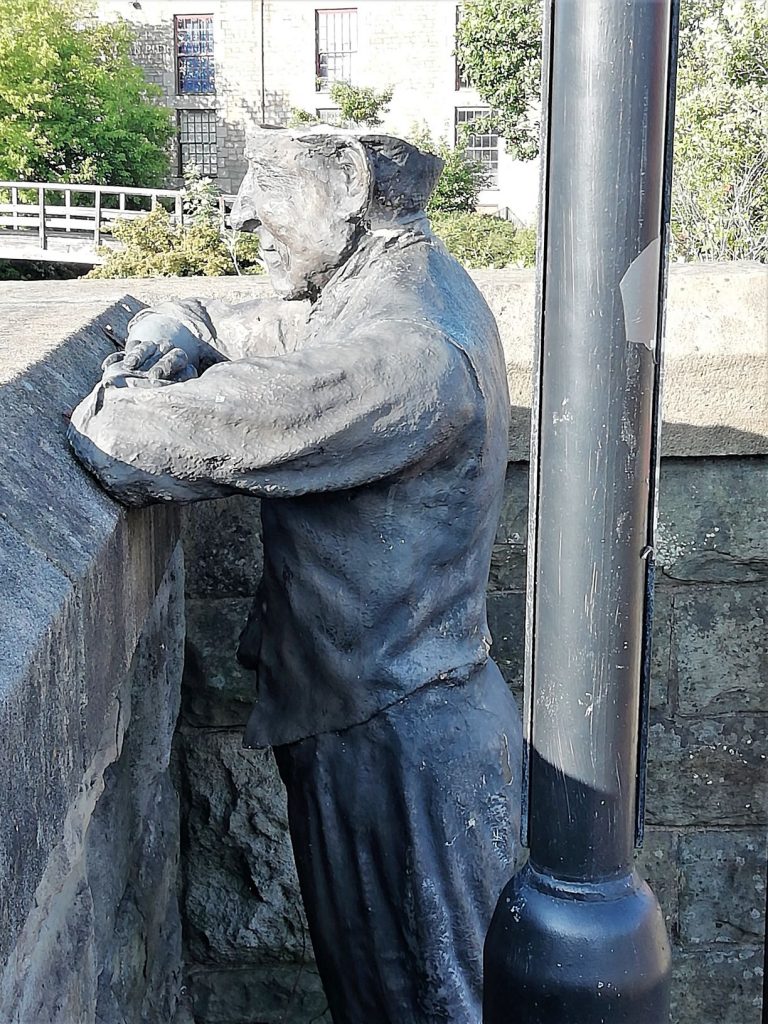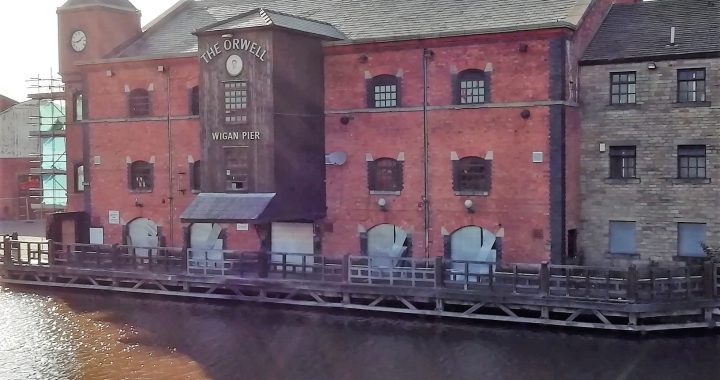A slightly calmer and less alarming week to follow the excitement of getting into Manchester.
Manchester City
We were finally deposited in Castlefield Basin about two thirty, safely before the schools let out, and ended up moored directly opposite the entrance to the Rochdale Canal we had just emerged from. Following a hot, sunny morning it began to rain just as we tied up, so after a quick lunch we went out to have a look around Manchester as it should be seen: damp.
As far as we could tell, it was very much a work in progress. We weren’t far from Deansgate, which seems to be a major thoroughfare and one that we had heard of. It is obviously a very crowded, busy city. The area we walked through seemed to be largely made up of Estate Agents and Interior Design businesses of one kind or another. We did come to an area that seemed to be much more devoted to the legal profession and there were smart bars and restaurants, already packed with post-work drinkers at four o’clock on a Monday afternoon.

Will they notice there is a bit missing?
Busy and cosmopolitan it may have seemed but that was also quite a thin veneer. We tried a couple of side routes to cut across to where we were heading and as soon as you took a couple of steps off the main drag you were back in the dingy, dirty back alleys that were uncomfortable to walk through. It made you feel you had stepped back in time as well as space and not in a good way. With that on the one hand and vast construction sites on the other we had probably had enough and headed back to the boat in time for tea, followed by a pre-prandial pint in the rain outside one of the nice pubs there. I have a feeling we might get more out of Manchester if we made a trip especially to do that for a couple of days, by car and staying in a hotel in the centre. As it is we’ve yet to see something that would make us want to come back.
Onto The Bridgewater
In order to provide a fixed position to book an engineer from Belling on Wednesday we had booked in to Bridgewater Marina in Boothstown for Tuesday and Wednesday night. Accordingly we set out on the Bridgewater Canal on Tuesday morning, putting the horrors of the Rochdale Nine firmly behind us.
The Bridgewater Canal is not owned or managed by CRT but is run by the Bridgewater Canal Company. We are able to travel along it for up to seven days at a time by virtue of a reciprocal licensing arrangement with the CRT. The contrast between Monday’s suffocating, subterranean adventure and today’s journey couldn’t have been more stark. We were now in the world of double width locks and wide canals. It was like emerging from the West End straight on to the M4, only without the traffic. The channel was wide and deep and we could comfortably travel at a flat out 4 miles per hour with plenty of room to pass oncoming traffic without slowing. Not that we saw much oncoming traffic.
The countryside around us was hardly stunning but it was open and flat, a lot of it brown field and as always there was plenty of development going on as we headed down past an area called Old Trafford. At one point we passed a large stadium belonging to one of the popular Association Football Clubs in the area. All credit to them for the condition of their facilities. The whole huge structure, all of the surrounding acres of car parking and all the various bridges and infrastructure elements across and around the canal were extremely clean and fresh looking, completely free of graffiti, clearly signposted and marked. Quite a refreshing change.
Shortly after this we turned off the main canal and up the Leigh Branch of the Bridgewater. Unsurprisingly, this eventually leads to Leigh. It seemed possible that this branch might be less wide or well-maintained than the main channel but not a bit of it. The junction was wide and easy to turn into and the canal continued broad, deep and uninterrupted, just as before. It might have been almost boring but there was plenty to see and it was a real pleasure to be able to just keep going without the obstacles and excitements of the Ashton & Rochdale.
Soon we passed an entrance to the Trafford Centre, which was very visible on our left. I managed to sneak us past before Sue noticed but I suspect we may find ourselves stopping there on our way back. We carried on and crossed the Manchester Ship Canal. Here the towpath, which at this point was carrying Bracken and I, is diverted over a separate crossing from the canal itself via a main road and re-joins some distance on the other side. Various aspects of this crossing, such as the possibility of the Barton Swing Aqueduct being closed to boaters, might have caused us issues but it was all plain sailing with no unexpected challenges.
Looking at the map, this whole journey up the Leigh Branch runs through a heavily built up area but we had no real sense of that at all. It was mostly kept quite firmly at bay behind wide grassy banks. The whole of the trip was accompanied by a very well maintained smooth-surfaced cycle path and for a lot of it a parallel path seemed to run along the off side. From the ship canal a fairly long straight stretch heads north to Parrin Lane where it rounds a bend to the north west. While the built up area carries on to the left, it drops away on the other side for Broadoak Park and Worsley Golf Club.
At this point the colour of the water had changed to a strange rusty brown colour and there seemed to be more weed around. Just as we came round the bend we found ourselves behind a big wide-beam work boat, travelling quite slowly, which we had actually watched leaving Castlefield Basin earlier in the morning. At the time we hadn’t seen any significance in the name “Water Womble” but watching the men on board it became clear that they were scooping up litter of all kinds from the canal. I later found this video about their activities:
Apparently they travel the length of the Bridgewater Canal scooping up all sorts of rubbish and wreckage to keep the canal clean. Whether they just do this for fun or they have a contract with the Bridgewater Canal Company is unclear.
Ahead, a hire boat had come into the towpath side and run itself aground in thick silt there. They were struggling to get away from the bank back into the main channel and in the process were looking rather unpredictable. The two men on the barge shouted advice but were not really in a position to help and could only hang back and wait until they were back in control. As I was walking the towpath with Bracken we were able to help push them off and we could all carry on in a little procession to Worsley Bridge.
Worsley Bridge is where the canal takes a fairly sharp turn to the west and it seems like a really nice, leafy community, well kept, with moorings and a services block there. You really feel that here you have finally shaken off the grime of Manchester and are back in the countryside. Unfortunately, as advised by the Water Womble, the water to the services block was turned off in May this year and ‘they’ are refusing to turn it back on, which seems pretty disappointing. It is unclear whether ‘they’ are the water company, the local council or the Bridgewater Canal Company. Fortunately, this time, it didn’t matter to us, as it wasn’t much further down the same broad, clear waterway to Bridgewater Marina where we would have access to all the services we could need.
Bridgewater Marina is not as new as Droylsden and seems to have grown up in a series of jetties and sheds around the outside of a bend in the canal. Nonetheless it has all the facilities, is locked and secure at night and there is a Greene King pub that sits on one side of the basin. There was a big field just beside the entrance for Bracken and access to the longer footpath that runs down the off side of the canal towards Worsley. We were allocated a floating pontoon, that was barely half our length, on the side closest to the main canal and had an entertaining half hour trying to work out the best way to ensure we were tied up securely with no way to secure a mooring line at the bow.
The Belling engineer was with us promptly on Wednesday morning and it came as no surprise to be told that they believe the issue is that the cooker has not been installed with the recommended space for ventilation and that is causing the igniter to keep clicking despite the grill being alight. Back to Aintree then, to modify the installation to meet the requirements printed in the owners manual. Since we were in the marina and could offer a postcode we had also been able to organise a supermarket delivery from Sainsbury’s to replenish our stores.
Checkpoint Leigh
While reviewing our, rather sketchy, plans in the marina we realised we would not be able to get down to Liverpool, which has to be pre-booked and has a limit on how long you can stay, get back out again and make it to a secure mooring in time to leave the boat there for two weeks while we made our next trip down south. That also meant that we had time on our hands so we shouldn’t rush. We made a rough plan for the next couple of days, starting with a short hop to the junction with the Leeds & Liverpool Canal at Leigh on Thursday.
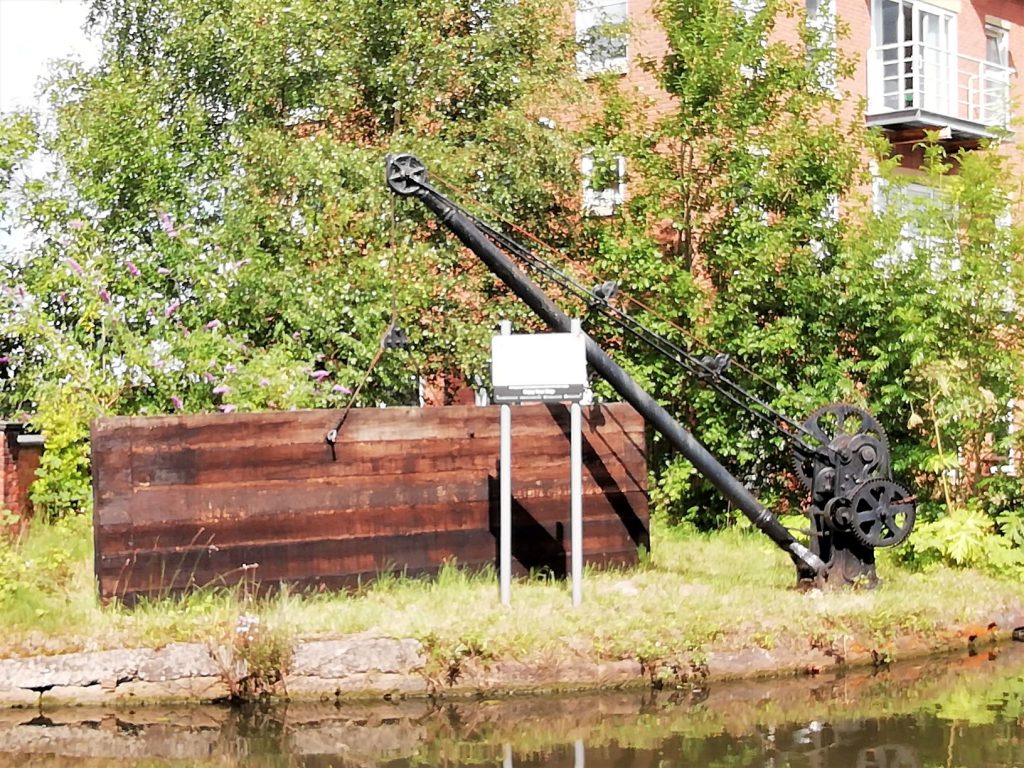
There is no junction here, as such, just a meeting of the Bridgewater Canal (Leigh Branch) and the Leeds & Liverpool Canal (Leigh Branch) with control passing back to CRT for the remainder of the route up to the main Leeds & Liverpool Canal at Wigan. There is a mooring just past the changeover point at Leigh Bridge and we pulled up here for a couple of nights and a bit of a re-think.
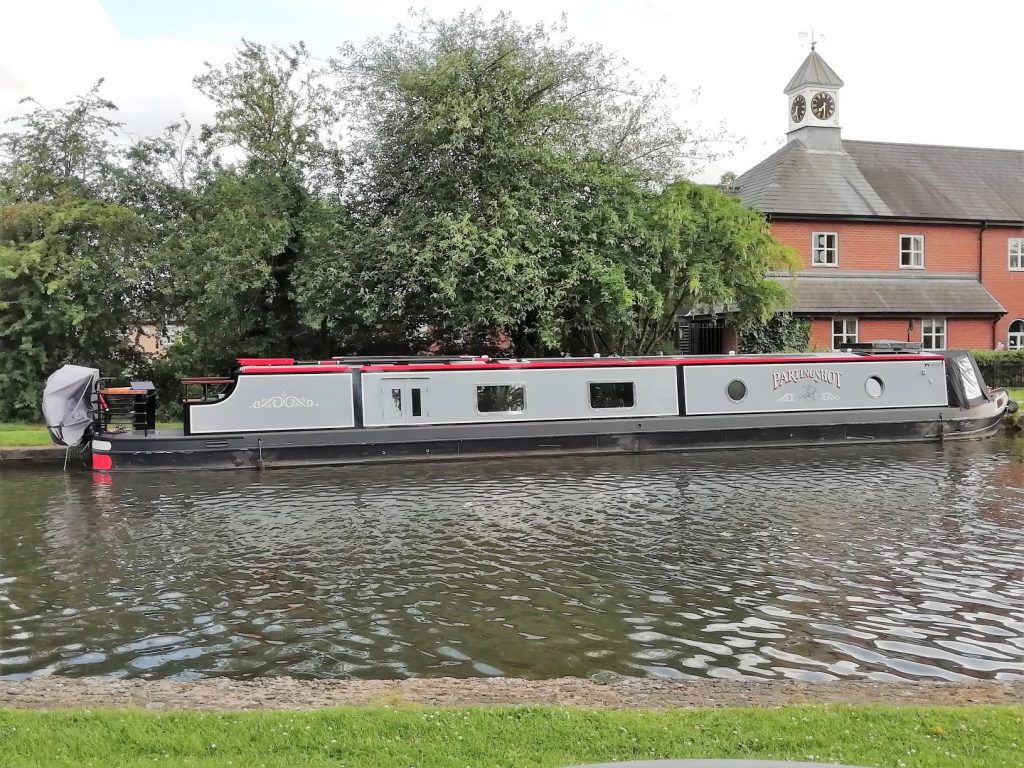

A damp Friday morning with frequent showers until lunchtime gave us an opportunity to do exciting things like renewing our car insurance, which was due for renewal at the end of next week. A brighter afternoon took us up into Leigh to run a number of errands, such as a trip to Specsavers to fix Sue’s glasses, which they did immediately and for free, with a full service and clean thrown in. Leigh itself is a busy place. Quite a big sprawl with a large pedestrianised precinct, a lot of run down and empty commercial premises but also a lot of signs of recent development. In the end it was very hard to tell if it was on the way up or on the way down. If the latter it probably can’t go down much further.
Our schedule gets set by strange priorities. Initially we were looking to be in Croydon sometime near Nick and my Mum’s birthdays. Our dentist is still in New Addington and the few days he works meant we had had to book both our routine check ups early on Wednesday 24th July. To get there we would need to pick up the car from home and drive down from Long Itchington on Tuesday 23rd July. With all the uncertainties of public transport we would have to travel down from the north on Monday 22nd July, which means we would need to have the boat settled in a marina for the night of Sunday 21st July, so we are ready to catch a train the next morning.
Looking at the options we found a marina halfway up the Rufford Arm of the Leeds & Liverpool that could accommodate us at a good price and was a very short walk to the station. We now had eight days to get there. A direct trip would probably take us three days. We reckoned that we could have a couple of quiet days on the way, explore the Rufford Arm and perhaps have a look at Rufford Hall on the way and then get back down the arm to the marina in time. The first step would be to get past Wigan.
Welcome To Wigan
Wigan sits on the Leeds & Liverpool Canal at the top of the Leigh Branch. It has a flight of twenty-one locks but thankfully they lie to the east of the junction. We would be heading west. Nothing about Wigan, from the name itself, to the sprawl on the map, to the reputation in the guides, had made us want to be there overnight so we had intended to pass through it and moor out in the open country beyond at a place called Crooke Bridge.
We had a straightforward run up to the end of the Leigh Branch where the Poolstock Locks lie just ahead of the junction. These are double locks but like the ones in Manchester they are secured with handcuff keys to try and deter vandals and are generally quite hard work. As it turns out, all the locks from here on, through Wigan and beyond, follow the same pattern but at least they are all above ground. By the time we reached the junction and made the turn it was already early afternoon.
Wigan doesn’t seem to have embraced the type of waterside development approach taken by many other towns. It pays tribute to its gritty industrial heritage by leaving it to decline, unmolested, to bear witness to the past and present. This strengthened our resolve to get through it as soon as possible. A shame really, as having dropped down one lock and entered the next lock, a couple of locals gave us two pieces of advice.
Firstly, they strongly recommended that, particularly on a Saturday, it would be unwise to proceed further unless we intended to get beyond Parbold. They said that from the point we had already reached it gets a bit rough especially past the football stadium. Although it generally pays to take notice of local intelligence like this and we hadn’t intended going that far we might, nonetheless, have pressed on were it not for their second bit of news. It seems that, as part of measures to save water, the next two locks were being padlocked closed from 15:00 each day until 08:00 the following morning. Since it was already 14:30 we didn’t feel we had much choice but to moor up here in the centre of Wigan and sit it out until morning.
Emerging from Lock 87 the published visitor moorings between Lock 86 and Lock 87 already lay behind us. However, on the short stretch between the lock and the next bridge, there were mooring rings on the towpath side and we could see a pontoon, with three boats moored against it, just beyond a water point and before the bridge so there were other boaters around. The unforgiving stone bank this side of the water point was a little higher than would be comfortable but was just about manageable and alongside the towpath were just a handful of tiny terraced cottages which looked inhabited and very well cared for with flowers in their little gardens. There seemed to be nothing around us that would attract any foot traffic up and down and in some afternoon sunshine it looked safe enough to moor here.
When another boat came down the lock, intending to stop for water and move on, they realised they couldn’t get through the next locks and moored behind us, so all the better. There was an older guy with two couples and a few kids. The older guy knocked on our boat a few minutes later. It turned out that this was his boat but his daughter was borrowing it for a few days and none of the others had ever been out on one before. He also asked if we would help them down the next few locks tomorrow as he would be leaving them tonight. Obviously, that worked for us. These were all hard work and two crews are better than one.
Wigan Pier
There is a Wigan Pier. It was just through the next bridge and round a left hand bend with a very short arm off to the right, which was still being used commercially by a trip boat. It seemed we were wrong about Wigan having made no attempt to exploit its canal side potential. At some point this area had been developed as a tourist destination with reference to Orwell and large pieces of mill machinery were positioned and displayed all around the buildings, one or two of which were actually intended to be museums. Here statues of working men were posed around the site and the centre piece was The Orwell, which advertised refreshments, boat trips, souvenirs etc.
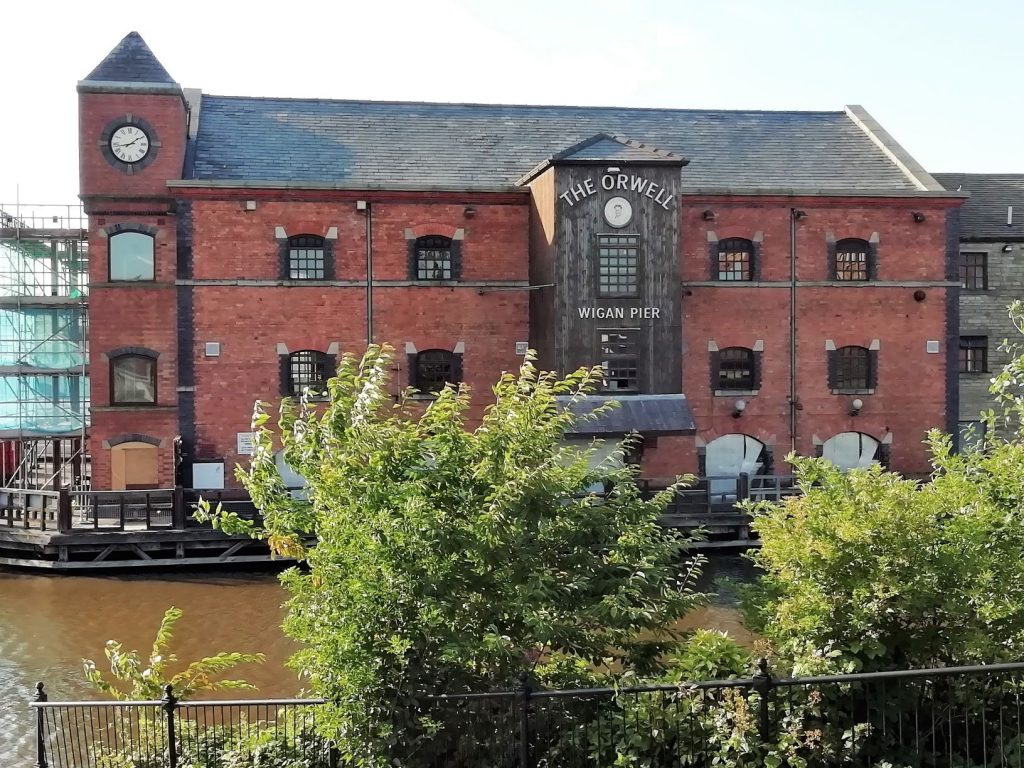
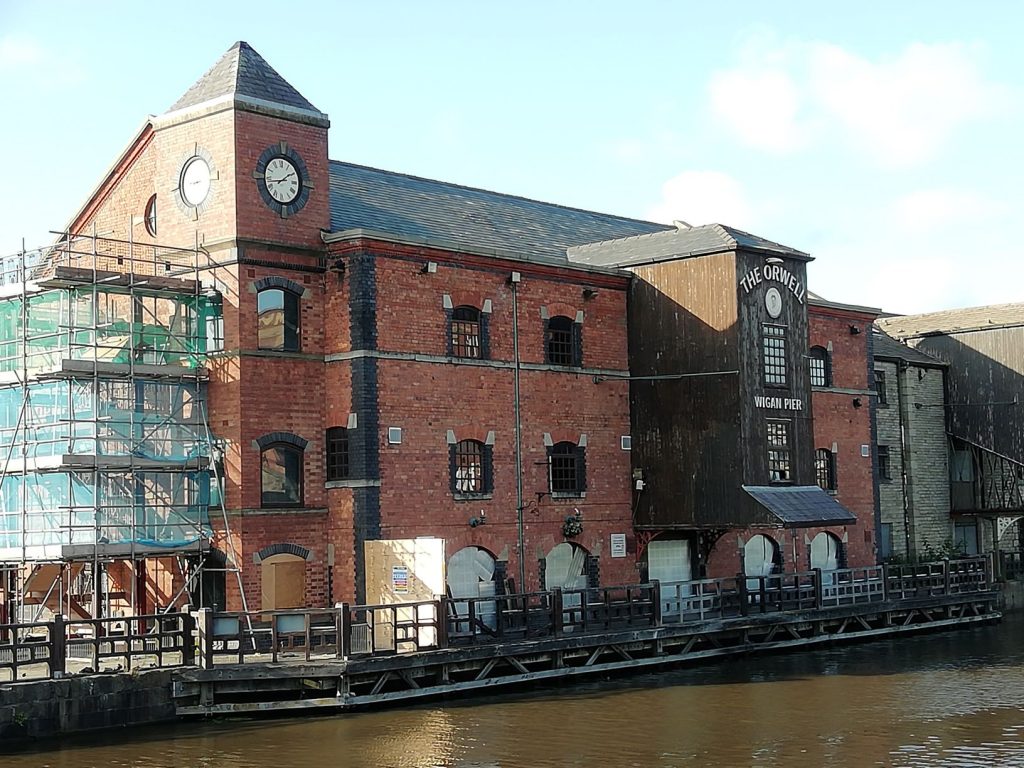
Looking more closely, however, you can see that these were the remnants of an attempt to revive the area as a cultural quarter starting in the eighties. It doesn’t seem to have been that successful anyway but failed completely when the financial crash came in 2008. The Orwell was derelict, the statues were disfigured and smashed and the whole site, along with all hope, was abandoned again. There are rumours that they’re about to have another go but I suspect it will mostly turn into apartments rather than public spaces.
